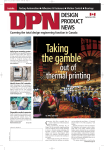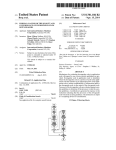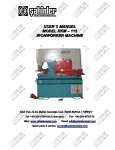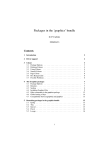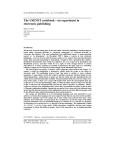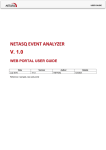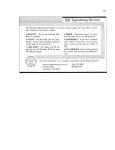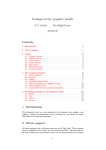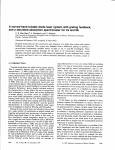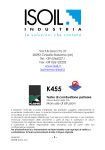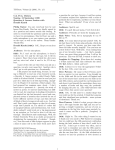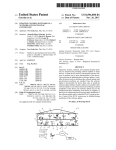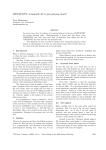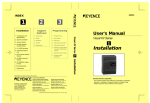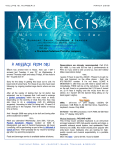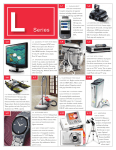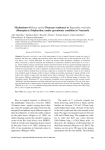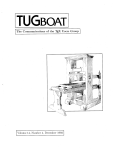Download Further Faces 1 Music 1.1 Dunne and Jiirgensen
Transcript
246 TUGboat, Volume 9 (1988), No. 3 Further Faces Dominik Wujastyk Since 'The Many Faces of W' appeared in issue 9.2 of TUGboat.' information about METAfonts has continued to flow in. thankfully in somewhat diminished quantities. Since I wrote the last article I have moved from the USA to England. and although all the network services are available here too (at a price), in practice Janet is not as open a medium as the Internet, and I feel it is more likely now that I might miss news about fonts, especially if it appears in UseNet, to which I currently have no access. I particularly miss the astonishing power of the American brand of F T P . However. the vast 'l&X archive at Aston, maintained by Peter Abbott. is more comprehensive than any other I know of. and NIFTP and mail server access to this archive greatly compensates for the sense of network isolation. All the same. if you know of any METAfonts that I have not mentioned. I would be glad of the news. For new subscribers to TUGboat, issue 9.2 contained a survey of the existing fonts known to be available for use with including non-roman scripts, other styles, and much besides. That issue also included METRFONT code and examples for a new punk METAfont called just PUNK. by Don K n ~ t h . Perhaps ~ the most extraordinary part of that article is Don's description of how he coded the font. extremely rapidly, and with no reference at all t o drawings for the letters from V to Z, producing the METRFONT code as fast as he could type! This demonstrates a completely new paradigm of typeface design and creation. which many graphic designers will find alien. but which evidently works for some people, a t least for smallish projects such as the punk typeface. People interested in METAFONT should be aware that in addition to past issues of TUGboat, mYha and U K W . Don Hosek's network magazine W M a G has regularly included information about fonts. and is required reading for METAFONTers. Volume 2 . issue 5, in particular, was dedicated to non-English and discussed Icelandic, German, French, ancient Irish, and the problems of foreign language hyphenation. Earlier issue of W M a G have also contained technical descriptions of TEX font file formats. etc. For information on sub- w. w. "The Many Faces of 7$X: a Survey of Digital METAfonts'. TUGboat 9.2 (1988), 131-151. 2 L APunk Meta-font', TUGboat 9.2 (1988), 152168. scriptions or back issues. contact Don Hosek. network address: DHosekOHMCVAX . Bitnet. Once again. I am beholden to those who provided the information I have merely marshalled below. 1 Music T J K W 1988. issues 28 and 29, carried an exchange of information recently, concerning the use of TEX to typeset music. This very challenging application has been receiving some attention, and the work to date was announced in the Music Research Digest. Thence it found its way to U K W . Phillip T . Conrad provided summaries of the work of Dunne and Jurgensen. that of Schofer and Steinbach, and of his own. 1.1 Dunne and Jiirgensen Dunne and Jiirgensen conducted research at the University of Western Ontario; they defined the concept of i-marks and p-marks. I-marks are invariant marks. the kind of marks that can be put into a font and typeset easily with W. P-marks are parameterized marks whose shape and size varies according to certain parameters. The only p-marks is capable of typesetting are the horizontal and vertical rules. Dunne and Jiirgensen use Postscript to augment the capability of l$jY with a special version of dvi2ps. Shane Dunne wrote to Sebastian Rahtz in August 1988. about his work on music typesetting. and Sebastian reproduced his letter in U K W , issue 28. Shane said the following: I was working on music printing per se about a year ago, and developed a rudimentary music-setting prototype based on T @ and PostScript. This system knows nothing of the rules of music formatting; the user describes the desired graphic result diusing its glue-setting capabilrectly to T@, ities to handle various problems of spacing. These days I have broadened my research focus to encompass all types of '.specialized notations" -those which use a fixed repertoire of symbolic marks -including music and music -like notations. logic diagrams, schematic representations of all kinds (e.g.. of automata), flow diagrams, etc. I think the existing "typesetting" paradigm can be extended to "marksetting". where a "mark" is any kind of symbol. not necessarily of fked form like a text character, but possibly dependent on one or more parameters (e.g., 2 endpoints for a line segment). I TUGboat, Volume 9 (1988). No. 3 am trying to develop a design for a generalpurpose marksetting system, which can be used as a software basis for any number of specialized formatting programs. i.e., a different front-end program for each class of notation. I am doing this research towards a Master's thesis in Computer Science. which I hope to complete before the end of December. In the meantime there is one technical report which discusses my earlier work on music-setting. including the prototype, and contains some early ideas about general mark- ~ e t t i n g . .~. My approach was simpler [than that of Schofer and Steinbach]; I used Postscript's powerful graphic primitives to define parametrized procedures to create things like beams and slurs. Schofer and Steinbach's fonts simply include huge numbers of different t e a m and slur characters. at different slants. etc., to handle a reasonable set of cases. The results look very good. Dunne has been somewhat overwhelmed by responses to this report on his work. which was in fact not really intended for general distribution. He followed up with a note which appeared in UKWX 1988. issue 29, to the effect that he had received a number of e-mail requests for more information from around the world. While pleased at the level of interest in his research, he explained that. just at the moment, he is not in a good position to reply to these queries: My problem is that right now, I am at a critical stage of writing my Master's thesis on this topic. and I simply cannot afford the time t o reply to all the letters I am receiving. Also. while I would love to send everyone a copy of my recent report. that will take time and money I don't have. I'm going to try and convince my Cniversity to take care of it. On a more positive note. my plans for the near future include finishing my thesis by this December. preparing a paper based on it for one of the computing journals (1'11 announce which one when I know). and preparing a distribution version of my mark-setting prototype. (The prototype cannot be distributed as is. because it's written for an experimental programming 3University of Western Ontario Technical Report 171. system that only existed here; and is now obsolete. It won't take much effort to t,urn it into straight C code. though.) So while I appreciate the interest in my work. I just wanted to let the . . . readers know that I'll be a bit of a hermit for ihe next few months! and that right now, 1 don't really have anything in the way of software to distribut,e. Contact (or not!) Shane Dunne? Dept. of Computer Science; Cniversity of Western Ontario, London. Ontario, N6A 5B7 CANADA ru'et: [email protected] . CA, [email protected] UseNet from US: . . . ! (ihnp4 ! decvax \ seismo) ! {watmath I utzoo) ! julian!uwocsd!shane LseNet frorn Europe: . . . ! mcvax!seismo !watmath!julian!uwocsd!shane 1.2 Schofer and Steinbach There is a thesis writt,en by Angelika Schofer and Andrea Steinbach at the Institut fiir Angewandte Mathematik at the Rheinische FriedrichWilhelms-Universitat at Bonn. entitled Automati- szerter IVotensatz mit TJ$. Schofer and Steinbach operated from the assumption that a font of beams and slurs is in fact feasible: they appear to have generated just such a font. and they use plain '&X alone. Their system appears to 'understand' some form of music-description language, and t o apply music-setting rules autornatically. The music is printed with %X by means of the special fonts. Availability ,4 copy of their work (in German) may be obtained for 25DM by writing to the Institut at: Wegler Strai3e 6' 5300 Bonn. Federal Republic of Germany. 1.3 Conrad Phillip T. Conrad noted that he is currently (August 1988) finishing a Master's thesis, at West Virginia University in Morgantown WV, which presents a prototype system for typesetting music not'ation with ?D)i. He noted that: It would seem that the central obstacle to musical t y p e s e t h g with TEX is the production of slurs (t,ies, phrase marks) and TUGboat, Volume 9 (1988); KO. 3 slanted beams. In John Gourlay's cover story in the May 1986 cover story of Communications of the ACM, he submits that it is a fair assumption that no two beams or slurs are precisely identical. so it would not be feasible to produce a font of all the possible slurs or beams. I have operated from this premise. as have Dunne and Jiir,nensen. My own approach builds on the previous work at the Ohio State University of Gourlay et al. announced in the CACM article mentioned above. I use the mYtyl program of John Renner (OSU Tech Report OSU-CISRC-4187-TR9) rather than Postscript to draw the beams and slurs. In theory this provides device independence; in practice. the following restrictions apply: 1) The target system must support METAFONT for generation of the vector fonts necessary to m t y l . 2) Three Pascal programs and one C program must be ported to the target system: at this time. the programs are written for only BSD Unix 4.3. Availability For copies of Conrad's thesis please contact him at the following address: Phillip T . Conrad. 401-K E. 3rd Street. Wilmington DE 19801-3964. U. S. A. Phone: (302)-652-3938 2 Hershey Fonts Just as I had begun wondering about the Hershey fonts. Jim Seidman asked about them in m h a x 1988. issue 70. 2.1 Guthery Dean Guenther (Guenther@WSUVMI. B i t n e t ) answered in issue 73 that Scott Guthery. (Phone: 512258-0785) has the Hershey fonts with TFMs for a nominal fee in the region of $20 or $30. 2.2 Kesner A few weeks later. w h a x 1988. issue 90, carried a letter from Oliver Kesner (9 October 1988), also in answer to Seidman's query. describing his own work converting Hershey fonts for use with w . I reproduce what he said: Hershey fonts for the IBM PC are available from SoftCraft, Inc., and from Austin Code Works. The SoftCraft set consists of four separate databases: 0 HERSHEY. CHR: 1594 characters. ORIENT. CHR: 758 characters, PERSIAN. CHR: 135 characters, HEBREW. CHR: 49 characters. The HERSHEY. CHR database includes, besides several Roman typefaces, Greek, Russian, German Frakt,ur, and a variety of graphic symbols; the ORIENT. CHR database has Hiragana, Katakana, and 623 Kanji characters. The format of t,he SoftCraft Hershey databases is given in their Font Editing: EFOIVT/CFONT User's Manual on p. AS-2. Using this description, I wrote . . . [a] Turbo Pascal 4.0 program t o generate METRFONT source code from the Hershey plotter directives. . . . The characters in the Austin Code Works Hershey database are numbered 14326, with gaps, for a total of 1,377 different alphabetic and graphic characters. The format is described in Yorman M. Wolcott and Joseph Hilsenrath, A Contribution to Computer Typesetting Techniques: Tables of Coordinates for Hershey's Repertory of Occidental Type Fonts and Graphic Symbols; U.S. Department of Commerce, National Bureau of Standards. April 1976. Oliver has provided the Turbo Pascal 4.0 source code of HERSHEY. PAS: a program that generates METAFONT source code from a Hershey character database in SoftCraft format, and ACWtoSC .PAS : a program that converts the Hershey font tables distributed by The Austin Code Works to the format expected by the Cfont program of SoftCraft, Inc. I.e., it converts the ACW Hershey database to SoftCraft format, from which HERSHEY. PAS can generate METRFONT. He also provides a pair of example files, ORIENT. LOG (the output of HERSHEY. PAS) and ORIENT. MF, which contain a couple of Japanese Hershey characters, and a set of font parameters respectively. I ran these through METAFONT, and was able to print the characters without a hitch. Terms of Availability The above information was forwarded to w h a x by Oliver's son, Jeff Kesner, who has an e-mail address TUGboat, Volume 9 (1988))No. 3 249 and is happy to act as postman. Contact him at: jok%[email protected]. The Pascal source code (about 14k) is available by anonymous F T P from Score.Stanford . edu (and from the Aston archive) as file Kesner.txh in the directory <t ex.t exhax>. 3 3.1 We have decided on the grid framework for the font. We also have thought about different global variables that could be used to control various features of the font. We have decided on a set of primitive curves. These are like subroutines that can be used by different letters. Some of these are coded in METRFONT. Only control points are determined. We are yet to determine the stroke thickness and pen angles at the control points. Since we are not imitating any font, it takes a lot of time trying t o ensure that various curves are correct. Our approach is to make a rough sketch and then determine the control points. Then we iterate by changing control points until the curve is satisfactory. But the most important thing to keep in mind is that all the curves must be consistent and be able to blend harmoniously. We essentially have the framework for Telugu font ready. But a lot of coding remains. In our spare time we will work on it. Some issues still remain unresolved. We are not sure what we should do to support transliteration of Sanskrit in Telugu. That means adding a lot of subscripts, superscripts. . . . Our file structure is basically like that in CMR. We have parameter, base driver, codes and program (right now empty) files. Armenian Karagueuzian Emma Pease also informed me that there is a family of Armenian fonts (created with old METAFONT) "wandering around CSLI". Dikran Karagueuzian designed and created these fonts in 1983. modelling them on Knuth's old CMR fonts. This means that they look good in bilingual typesetting with CMR. In fact. there is also an Armenian to go with these fonts. Its hyphenating algorithm, designed by John Hobby and Dikran Karagueuzian. is functional but, according to Dikran, not perfect. so that the user may have to fiddle with the typeset material at the end. Contact The Armenian family of fonts, as well as the Armenian is available to anyone who wishes to use them. Contact Dikran Karagueuzian (dikranQcsli . stanf ord.edu). w. 4 Logic Diagrams U K W 1988. issue 30. included a letter from David Osborne (cczdaoQuk.ac nott cian) mentioning a font called milstd.mf created by Rick Simpson for drawing electrical symbols. He included the METAFONT source code for the font. and in the following issue of U K W , a small set of macros were published, for making the logical symbols easier to use within plain or I4w.The font consists of the following 25 symbols: slanting line at 45-degree angle for marking busses in logic diagrams: AND. NAND, OR, NOR gates, facing to the right. down. left and up: buffer and inverter, each facing to the right, down, left and up. 5 5.1 Tamil Arthanari There has been no communication from Mr. Arthanari. and it looks very much as though the Ridgeway-Schiffman font holds the greatest promise of a usable Tamil font in the near future. 6 Telugu The latest news from Mukkavilli Lakshmankumar and his wife Lakshmi about T e l u g u w is as follows: 7 JW Emma Pease (emmaQcsli . stanf ord . edu) mailed me on July 5 1988 with a correction about the availability of J m Y : a Tops-20 version of JT$jX no longer exists on Turing since the old Turing machine itself no longer exists. 8 8.1 Greek Hamilton Kelly First of all. I apologize heartily for getting Brian's name wrong. The correct surname is 'Hamilton Kelly'. not just 'Kelly' (it's been that way since 1638!). I, of all people. should understand about unusual names! My report about Brian's work on Greek METAFONT characters was written at second hand. and he was astonished (and I hope pleased) when he came across a description of his Greek METAFONT work in TGGboat. This has spurred him into polishing up what he has done, and resubmitting it t o the 'QX archive at -4ston. Explaining the genesis of his work. Brian says: TUGboat, Volume 9 (1988), No. 3 I wanted access to a Greek font to type my homework. since I am currently learning Modern Greek at an evening class (for general interest, and for holidays). What I did was to take the character definitions already used in the maths italic for the lowercase Greek letters. along with the uppercase ones. and the normal ROMANU which make up the Greek upper-case and put them into a new driver file: I then METAFONTed this with various parameter files such that they now had spacing defined, etc., for use as a normal textual font. Brian completed this work before hearing of Silvio Levy's work at Princeton, but continues to use his own Greek since it does not require a DVI output program which can read fonts of 256 character^.^ Brian has now written a small macro package which eases considerably the selection of the Greek fonts; this is for use under PT@Cand makes use of the \Qaddf o n t i n f o macro to define the font changing commands such that they scale automatically with I P ' Y ' s size-changing commands. He has also written a short paper. describing what he has generated, and his future directions. He has recently been refining the character programs. to make some of the letters more textual in appearance (for example, the alpha was very wide: fine for maths. but not in text). 2. A preprocessor with customizable mapping of the basic 29 chars to a-z, A-Z areas of an ASCII keyboard, that will work out an intermediary file such that unmodified 'Q$ plus a few macros does indeed correctly compose bidirectional texts. The preprocessor reassigns the correct glyph from the isolated form glyph depending on the position in word. All this will continue to be made available free to the academic community. No vowel marking scheduled at this time. but Jacques says he could do it if requested. It would be implemented just like the accents in normal TEX. 10 10.1 11 In the 'Many Faces' article, I failed t o mention that Jorgen Pind had written a full account of his work on Icelandic EX which appeared in Don Hosek's W M a G , volume 2, issue 5 . Brian has sent both the above mentioned files to the Aston archive. together with the revised font files, where all the material will be freely available. An announcement giving details will have appeared in U K W by the time you read this. 12.1 9.1 Goldberg In early September Jacques Goldberg noted that there has been a lot of progress with the Arabic font. He hoped to have it out by the end of September, all being well. The font consists of: 1. A complete font of 29 characters each at 2 or 4 glyphs (position dependent, isolated, first, middle. last in word). 4Bill Kaster of Personal TEX Inc., has recently produced a version (1.00t) of their Hewlett Packard LaserJet driver. PTI LASER/HP. which copes beautifully with Silvio's large font. I understand from Bill that their Apple Laserwriter driver, PTI LASER/PS, already has this capability. Icelandic 11.1 Pind 12 Perso-Arabic Century Schoolbook: Liber In TUGboat 9.2. Georgia gave more information about the process of designing the Century Schoolbook typeface she has been working 011.~The face is now christened Liber. and the article was printed in the new face. at a resolution of 300dpi. Terms of Availability 9 Georgia Tobin Miscellaneous Hosek Pica Don Hosek (of .'Output Devices" and W M a G fame) has created a CM Pica, using the METRFONT code of the typewriter style font. CMTT. of Computer Modern as his point of departure. CM Pica is more or less a l0cpi version of CMTT with heightened ascenders and x-height, similar to the Xerox1200 PICA font in appearance. CM Pica is specially designed as a sop to University authorities. some publishers' editors and the like. who insist on having a typescript manuscript marked up in the traditional manner. i.e.. with a squiggly line under bold characters, and underlining under characters which would be italicized in print. To achieve this, Don created 'bold' and 'italic' fonts (CMPICAB . MF , CMPICATI . MF) in which each character includes an under-squiggle. or underline respectively. Don also modified the l i g t a b l e commands controlling begin and end quotes and also hyphens, so that " and ' ' both become ", while 5'Designing for Low-Res Devices', TUGboat 9.2 (1988), 126-128. TUGboat, Volume 9 (1988), No. 3 ' and ' both become [the single straight quote symbol at code '015 in CMTT). Similarly, on output. ' - - ' becomes '-' and '---' becomes '--'. The upshot is that one can code up a document in normal TEX fashion and then. by setting the fonts to be Hosek's Pica, it will print out looking as though it had been typed. with 'italic' text underlined and 'bold' text under-squiggled, etc. Merely reset the fonts to CMR (or whatever) and it will be properly typeset with all the variety of fonts and refinement of punctuation of which is capable. 12.2 Non-standard sizes of CM John Sauter reported in TUGboat 7.3 (1986), 151152, that he has re-parameterized CM so that any of the existing Computer Modern family may be created with any design size. For example, most of us, when requiring an l l p t CMR will use CMRlO a t \magstep half. Apparently this is not satisfactory t o the most discerning, and Sauter's algorithms permit one to generate a true CMRll face. They go further, of course, and permit the generation of any of the CM faces in any (reasonable) point size. This is done by algorithms that interpolate or extrapolate from the values used by Knuth in the METAFONT parameter files for CM. If a standard value, such as 10pt. is chosen. then Sauter's algorithms will produce CM fonts identical to the standard ones. The TFM files for all sizes match exactly. Don Hosek's W M a G , volume 2. number 4 gives further details of Sauter's work, and notes that some of the fonts may start looking bad a t larger sizes. lacking inter-character space, and so on. Don has prepared a version of Sauter's work tailored for use on a P C , which is available from him. See the M M a G article for details. Output Devices Output Devices Don Hosek The device tables on the following pages list all the TEX device drivers currently known to TUG. Some of the drivers indicated in the tables are considered proprietary. Most are not on the standard distribution tapes; those drivers which are on the distribution tapes are indicated in the listing of sources below. To obtain information regarding an interface. if it is supposed to be included in a standard distribution. first try the appropriate site coordinator or distributor; otherwise request information directly from the sites listed. The codes used in the charts are interpreted below, with a person's name given for a site when that information could be obtained and verified. If a contact's name appears in the current TUG membership list, only a phone number or network address is given. If the contact is not a current TUG member. the full address and its source are shown. When information on the drivers is available, it is included below. Screen previewers for multi-user computers are listed in the section entitled "Screen Previewers". If a source has been listed previously under "Sources". then a reference is made to that section for names of contacts. Corrections, updates, and new information for the list are welcome: send them to Don Hosek, Bitnet DhosekOHmcvax (postal address. page 229). Sources ACC Advanced Computer Communications, Diane Cast, 720 Santa Barbara Street, Santa Barbara, CA 93101, 805-963-9431 (DECUS, May '85) Adelaide Adelaide University, Australia The programs listed under Adelaide have been submitted to the standard distributions for the appropriate computers. The Postscript driver permits inclusion of Postscript files in a file. The driver is described in TUGboat, Vol. 8: No. 1. AMS American Mathematical Society, Barbara Beeton, 401-272-9500 Arpanet: BNBBMath. AMS .corn Arbor ArborText, Inc., Bruce Baker, 313-996-3566, Arpanet: BwbBArbortext .Corn ArborText's software is proprietary and ranges in price from $150 to $3000. The drivers for Postscript printers, the HP LaserJet Plus, the QMS Lasergrafix, and Imagen printers are part of their DVILASER






